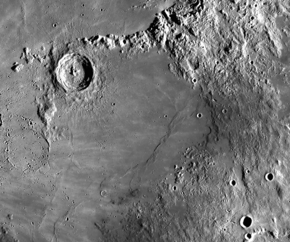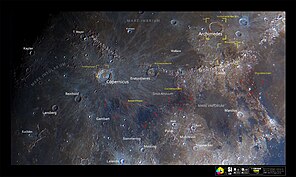| This article needs additional citations for verification. Please help improve this article by adding citations to reliable sources. Unsourced material may be challenged and removed. Find sources: "Sinus Aestuum" – news · newspapers · books · scholar · JSTOR (December 2009) (Learn how and when to remove this message) |
 | |
| Coordinates | 12°06′N 8°18′W / 12.1°N 8.3°W / 12.1; -8.3 |
|---|---|
| Diameter | 290 km |
| Eponym | Seething Bay |


Sinus Aestuum /ˈsaɪnəs ˈɛstjuːəm/ (Latin sinus aestuum "Seething Bay") forms a northeastern extension to Mare Insularum. It is centered at selenographic coordinates 12.1° N, 8.3° W, and it lies within a diameter of about 320 km.
The Sinus Aestuum is a level, nearly featureless surface of low albedo basaltic lava that is marked by a few small impacts and some wrinkle ridges. The eastern border is formed by an area of irregular terrain that divides the bay from the Mare Vaporum to the east. To the north is the Montes Apenninus range and the prominent crater Eratosthenes. Along the western side is the flooded crater Stadius and the Mare Insularum to the southwest.
See also
References
- ^ "Sinus Aestuum". Gazetteer of Planetary Nomenclature. USGS Astrogeology Research Program.
External links
- Sinus Aestuum at The Moon Wiki
- Maps with current names of surface features: western part, eastern part
- Images of Sinus Aestuum by Apollo 12
- Images from the Lunar Reconnaissance Orbiter online with information about the image's location that was in and around Sinus Aestuum:
- Wood, Chuck (February 28, 2005). "What's Happening at Aestuum?". Lunar Photo of the Day. Retrieved August 29, 2017.
- Wood, Chuck (August 2, 2007). "A Radial Section of Debris". Lunar Photo of the Day. Archived from the original on August 16, 2015.
| Lunar maria | |
|---|---|
| Oceanus | |
| Mare | |
| Lacus | |
| Sinus | |
| Paludes | |